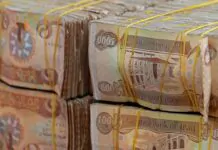Good morning,
Trump Mulls Post-War Gaza Plan Featuring Tokenized Land
Report suggests US takeover of Gaza with blockchain-based land tokens for Palestinians
US Trusteeship and the GREAT Trust
The Washington Post reports that a 38-page prospectus, titled the Gaza Reconstitution, Economic Acceleration and Transformation Trust (GREAT Trust), is circulating within the Trump administration.
The plan would see the United States take over Gaza under a trusteeship for at least 10 years. It proposes a “voluntary” relocation program for Gaza’s two million residents, offering them digital land tokens in exchange for their property. These tokens could later be redeemed for housing in newly built “smart cities” or for relocation elsewhere.
Residents would also receive temporary support, including four years of rent subsidies, food assistance for one year, and a $5,000 relocation stipend.
Criticism and Legal Questions
The plan has already sparked backlash. The Council on American-Islamic Relations (CAIR) called the tokenization scheme “morally abhorrent and illegal under international law,” warning that it would amount to “a war crime of historic proportions.”
The Washington Post further noted that the proposal was developed by the same individuals behind the US- and Israel-backed Gaza Humanitarian Foundation, with financial planning support from a team formerly with the Boston Consulting Group.
Blockchain Registry and Tokenized Land
A central feature of the proposal is a blockchain-based land registry. Gaza’s land would be tokenized into fractional units that could be:
- Sold to investors on secondary crypto markets
- Used to fund reconstruction and humanitarian projects
- Traded digitally, with all transactions recorded on blockchain
Gazan landowners would be issued tokens upon handing over their land, redeemable for either cash or apartments in the strip’s future smart cities. The plan also claims that relocating residents outside Gaza would reduce costs by $23,000 per person.
Returns from the scheme are pitched as reinvestments into a “Palestinian Wealth Fund” for future generations.
Smart Cities and Mega-Projects
Beyond tokenization, the prospectus outlines ambitious development goals, including:
- 6–8 AI-powered smart cities with digital ID-based economies
- 10 mega-projects such as ports, highways, a railway, an AI datacenter
- Dubai-style artificial resort islands
- An “Elon Musk Smart Manufacturing Zone”
The Trump administration has increasingly tied its Middle East economic strategy to blockchain and tokenization. Trump himself remarked earlier this year that the US should “take over” Gaza to make it the “Riviera of the Middle East.”
Why This Matters
If pursued, this plan would represent one of the most radical applications of blockchain to geopolitics and post-war reconstruction. While supporters argue it offers a path to rebuild Gaza through digital finance, critics view it as a form of land dispossession and forced displacement under the guise of innovation.
@ Newshounds News™
Source: Cointelegraph
~~~~~~~~~
What’s Behind XRP’s Move to DeFi?
Ripple is steering XRP into a new era with institutional backing, wrapped tokens, and yield-generating protocols
Turning Point for XRP in 2025
This year has been pivotal for XRP. In July, the token surged to an all-time high of $3.58, fueled by legal clarity and institutional rotation into under-owned digital assets. Ripple’s launch of the RLUSD stablecoin added momentum, while new technical upgrades are expanding XRP’s reach into decentralized finance (DeFi).
The catalyst came when the SEC dropped its case against Ripple, removing years of regulatory uncertainty. Coupled with the Trump administration’s pro-crypto GENIUS Act, institutional capital began flowing more freely into XRP. The token is increasingly being revalued not as a speculative play, but as a capital layer within a broader financial system.
Institutional Concentration and Exchange Integration
XRP’s ownership dynamics reflect its institutional character. Roughly 41% of supply sits in the top 10 wallets, over 70% in the top 100—patterns more in line with traditional financial assets than retail-driven tokens.
Coinbase added to this momentum in July by launching cbXRP, a wrapped token backed 1:1 by XRP for cross-chain use. DeFi lending protocol Moonwell was first to integrate cbXRP, allowing users to lend and borrow with it. Liquidity on Moonwell has already surpassed $1.2 million, marking a meaningful first step in XRP’s decentralized journey.
These shifts highlight how XRP is moving beyond simple exchange trading into structured financial infrastructure.
Expanding Into DeFi
Ripple’s ecosystem expansion continues through interoperability and smart contract functionality. The XRPL EVM sidechain is opening doors to broader DeFi integrations, while Flare Network is building dedicated infrastructure for “XRPFi.”
Flare’s FAssets allow XRP to be wrapped as FXRP in a non-custodial, smart contract–based framework, enabling cross-chain use without centralized intermediaries. Analysts see this as a natural next step. As Gabriel Halm of Sentora put it, XRP’s DeFi push is “an intuitive next step in creating a comprehensive finance ecosystem for XRP.”
Yield Opportunities on the Horizon
Right now, yield opportunities for XRP remain limited—cbXRP suppliers on Moonwell earn around 0.1%. But Flare’s upcoming Firelight Protocol could change that. Modeled after Ethereum’s EigenLayer, Firelight will enable staked XRP to secure new DeFi applications, unlocking additional yield streams and powering use cases like on-chain insurance.
Flare Co-Founder Hugo Philion described the vision: “Firelight offers on-chain XRP yield opportunities, both for institutions and retail holders, improving capital efficiency for XRP and further bolstering its utility.”
Looking Ahead
XRP’s story is evolving from short-term price action to structural transformation. With stablecoin integration, wrapped token adoption, institutional concentration, and new yield-generating protocols, XRP is positioning itself as both an institutional settlement layer and an emerging DeFi asset.
If adoption continues, XRP could solidify its role as a bridge between traditional finance and the decentralized economy.
@ Newshounds News™
Source: CryptoSlate
~~~~~~~~~
Bank of China Stock Jumps Amid Rumors of Stablecoin Licensing Plans
Hong Kong’s new stablecoin regime sparks speculation as Bank of China explores digital asset opportunities
Stock Surge on Licensing Reports
The Bank of China’s Hong Kong branch saw its shares climb 6.7% on Monday, closing at HKD $37.58. The rally followed local media reports that the bank is preparing to apply for a stablecoin issuer license under Hong Kong’s newly launched regulatory regime.
The Hong Kong Economic Journal reported that the bank had formed a dedicated task force to explore stablecoin issuance. While Bank of China declined to comment, executives confirmed during last week’s earnings call that research into digital assets and risk management is ongoing.
Hong Kong’s Stablecoin Framework
On August 1, Hong Kong introduced its stablecoin licensing regime under the Hong Kong Monetary Authority (HKMA). Issuers must now meet strict standards around:
- Reserve management and redemption guarantees
- Segregation of client funds
- Anti-money laundering compliance
- Disclosure requirements and operator vetting
The framework closely follows the U.S. GENIUS Act, Washington’s first federal stablecoin law, and is already attracting major banks and fintech players. Standard Chartered has expressed interest, while Chinese tech giants JD.com and Ant Financial are also exploring applications abroad to support international business.
JD.com founder Richard Liu has said the company sees stablecoins as a tool to cut cross-border payment costs, starting with B2B transfers before expanding into consumer markets.
Institutional Interest and Market Potential
Vincent Chok, CEO of Hong Kong-based First Digital, emphasized the appeal: “Blockchain technology reduces settlement times and bypasses the traditional intermediary fees of banks,” he told Decrypt. The opportunity is particularly strong in emerging markets, where stablecoins can hedge against currency volatility.
Chok added: “The current trajectory suggests exponential growth in the next 2–5 years, as regulation provides clarity and adoption accelerates.”
Regulatory Caution
Despite the excitement, regulators are urging restraint. Both the Securities and Futures Commission (SFC) and the HKMA warned investors in mid-August that speculation-driven price moves could be misleading.
“These movements appear to follow corporate announcements, news reports, social media posts or speculations regarding plans to apply,” they noted. “Given the significant uncertainties surrounding the outcomes of these preliminary plans or applications, the abrupt market movements… highlight the need to stay vigilant.”
Why This Matters
If confirmed, Bank of China’s entry into stablecoin issuance would mark a major step for state-backed financial institutions in Hong Kong’s digital finance sector. It could also signal a broader alignment between China’s financial infrastructure and the global push toward regulated stablecoin adoption.
@ Newshounds News™
Source: Decrypt
~~~~~~~~~
Putin, Xi, Modi Advance Anti-Dollar Pact With New SCO Bank
Shanghai Cooperation Organization summit signals historic shift in global financial power
Xi’s Strategy and the SCO Bank
The Shanghai Cooperation Organization (SCO) summit in Tianjin, China has drawn more than 20 world leaders — the largest attendance in the group’s history. Hosted by President Xi Jinping, the event brought together Russia’s Vladimir Putin and India’s Narendra Modi, alongside leaders from U.S. partners such as Turkey and Egypt.
At the center of the discussions is the creation of a new SCO bank, an initiative aimed at reducing reliance on the U.S. dollar and Western-dominated financial institutions. Observers say Xi is seizing on America’s strained alliances to present China as the second global power center.
As journalist David Pierson noted from the summit, China has effectively told Washington: “You are no longer calling the shots.”
Global Trade Shift and Financial Infrastructure
The SCO’s financial strategy is designed to bypass dollar-based systems through independent payment networks and alternative banking mechanisms. The initiative comes as Trump’s tariff policies push traditional U.S. allies closer to Beijing, while Modi’s participation signals India’s openness to exploring non-dollar trade solutions amid ongoing disputes with Washington.
Pierson underscored the broader implications: “The Trump administration has upended the U.S. alliance system. It’s gifting this incredible opportunity to Xi Jinping to pull friends away from the U.S.”
Military Display Reinforces Economic Message
Following the summit, China staged a large-scale military parade, underscoring its growing influence and its challenge to the Western-led financial and security order. The display reinforced the SCO’s positioning as not just an economic alliance, but a geopolitical counterweight to Washington.
Why This Matters
The SCO bank represents a direct challenge to dollar hegemony, combining financial, geopolitical, and military messaging. With members citing sanctions and autonomy as drivers, the bloc is accelerating the search for alternatives to U.S.-controlled financial systems.
As the anti-dollar pact strengthens, the global economic balance is being reshaped in real time, with China, Russia, and India at the forefront of building a parallel financial infrastructure.
@ Newshounds News™
Source: Watcher.Guru
~~~~~~~~~
Seeds of Wisdom Team RV Currency Facts Youtube and Rumble
Newshound’s News Telegram Room Link
Follow the Roadmap
Follow the Timeline
Seeds of Wisdom Team™ Website





